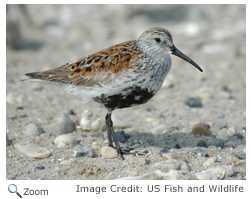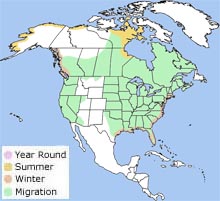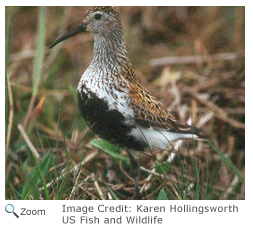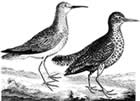Description
 The dunlin is a medium-sized shore bird about 7 to 8 inches in length. It has a long, dark bill with a little downward dip at the end. It has a black patch on its belly and black legs. Its back and wings are reddish-brown, and its head and chest are white with brownish specks. In the winter, the dunlin is a grayish color. The dunlin used to be known as the red-backed sandpiper. The dunlin is a medium-sized shore bird about 7 to 8 inches in length. It has a long, dark bill with a little downward dip at the end. It has a black patch on its belly and black legs. Its back and wings are reddish-brown, and its head and chest are white with brownish specks. In the winter, the dunlin is a grayish color. The dunlin used to be known as the red-backed sandpiper.
Range  The dunlin breeds from western and northern Alaska east to the Hudson Bay. It winters along the coast from southern Alaska and Massachusetts south to Mexico. It is also found in northern Europe and Asia. The dunlin breeds from western and northern Alaska east to the Hudson Bay. It winters along the coast from southern Alaska and Massachusetts south to Mexico. It is also found in northern Europe and Asia.
|
|
HabitatThe dunlin nests on the tundra and winters on beaches, river and lake shores, mudflats and sandflats.
Diet  The dunlin eats insects and larvae, marine worms, small crustaceans, snails, and small fish. The dunlin is sometimes called the "sewing machine" because of the way it bobs its head up and down and pokes into the ground as it probes for food. The dunlin eats insects and larvae, marine worms, small crustaceans, snails, and small fish. The dunlin is sometimes called the "sewing machine" because of the way it bobs its head up and down and pokes into the ground as it probes for food.
Life Cycle The female dunlin lays four eggs. The chicks hatch in 21-22 days and fledge when they are 19-21 days old.
Behavior
In winter, dunlins gather in huge flocks. If they are startled, they all fly off together, turning and flying in unison!
|



 The dunlin breeds from western and northern Alaska east to the Hudson Bay. It winters along the coast from southern Alaska and Massachusetts south to Mexico. It is also found in northern Europe and Asia.
The dunlin breeds from western and northern Alaska east to the Hudson Bay. It winters along the coast from southern Alaska and Massachusetts south to Mexico. It is also found in northern Europe and Asia.